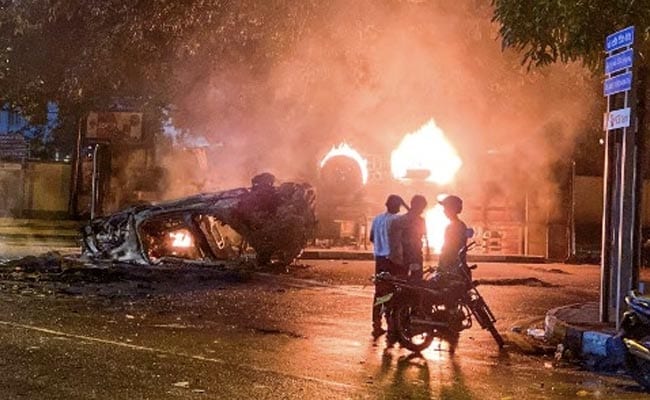SRI LANKA CRISIS UPDATE: The former prime minister of Sri Lanka, Mahinda Rajapaksa, sought sanctuary at a naval installation on the island nation’s northeast coast as fatal demonstrations swept across the country and thousands of protestors defied a statewide curfew to vent their displeasure over the country’s worst economic crisis ever.
The day before, violent riots left five people dead and led to the resignation of Prime Minister Mahinda Rajapaksa, who together with his brother, President Gotabaya Rajapaksa, is blamed for plunging the country into chaos. The Trincomalee Naval Base in Sri Lanka was the site of a protest when it was reported that the former prime minister and some of his family members had arrived there after leaving the government house in Colombo.
Thousands of enraged protestors invaded Mahinda’s official house throughout the night, and he was rescued in a Tuesday morning military operation. According to his son, Mahinda will not depart the country.
With tens of thousands of security officers imposing a curfew, the defence ministry announced that troops “had been instructed to kill on sight anyone plundering public property or endangering life.”
Protesters and a major trade organisation demanded that a new administration take charge of the crisis-stricken nation, as the president urged for calm a day after eight people were murdered in violence. With Rajapaksa’s resignation, the cabinet was also disbanded, leaving a void in the administration.
Constitutionally, the President has the highest authority, but a prime minister and cabinet are required to operate the government. In the event of a presidential vacancy, the prime minister is also the next in line.
Protesters enraged over gasoline, cooking gas, and electricity shortages disregarded the curfew to assault government leaders, torching the houses, stores, and enterprises of ruling party legislators and provincial politicians. Yesterday it was the 32nd consecutive day that protesters surrounded the door to President Gotabaya Rajapaksa’s office in the capital, demanding that he follow in his brother’s footsteps and resign.
The Rajapaksa clan’s grip on power has been weakened by months of blackouts and shortages in Sri Lanka, the country’s most severe economic crisis since its independence in 1948. The attacks on Monday, however, marked a tipping point after weeks of peaceful protests.
Police used tear gas and water cannon to disperse protesters in Colombo and announced an instant curfew, which was eventually extended to the entire 22-million-person South Asian nation.
Monday, when government supporters arrived in Colombo by bus and beat demonstrators with sticks and clubs, almost 200 protesters were hurt. “We were struck, as were the reporters, ladies, and children,” a witness told AFP. During the rioting, numerous politicians’ residences, including the ancestral home of the Rajapakshas in Hambantota, were torched.
The former president of Sri Lanka, Chandrika Kumaratunga, cautioned against violence in a tweet, stating that “saboteurs may encourage violence to pave the way for military dictatorship.” President Rajapaksa is a former military officer with supporters in the armed services. Authorities have announced that the curfew would be removed on Wednesday morning, with government and private offices, stores, and schools required to stay closed on Tuesday.
The United Nations condemned the escalating violence, and the UN’s head of human rights, Michelle Bachelet, urged the authorities to prevent more unrest. In a statement made on Tuesday, Bachelet said, “I am gravely concerned by the escalation of violence in Sri Lanka when supporters of the prime minister attacked peaceful demonstrators in Colombo on May 9 and by the subsequent mob violence against members of the ruling party.”
As a result of the eruption of violence, opposition groups said on Tuesday that they’ve terminated unification negotiations with institutions. People have been forced to wait in line for months to purchase necessities because a foreign exchange crisis has led imports of everything to plummet, resulting in catastrophic food shortages and rolling power outages.












